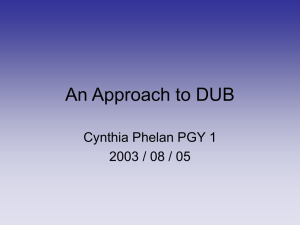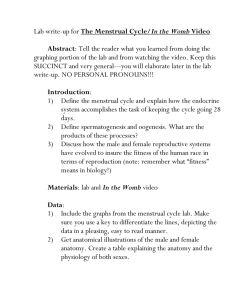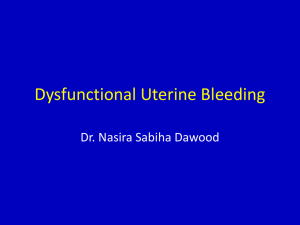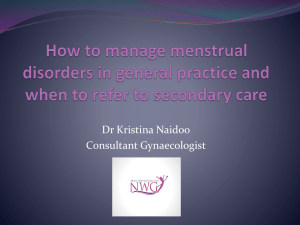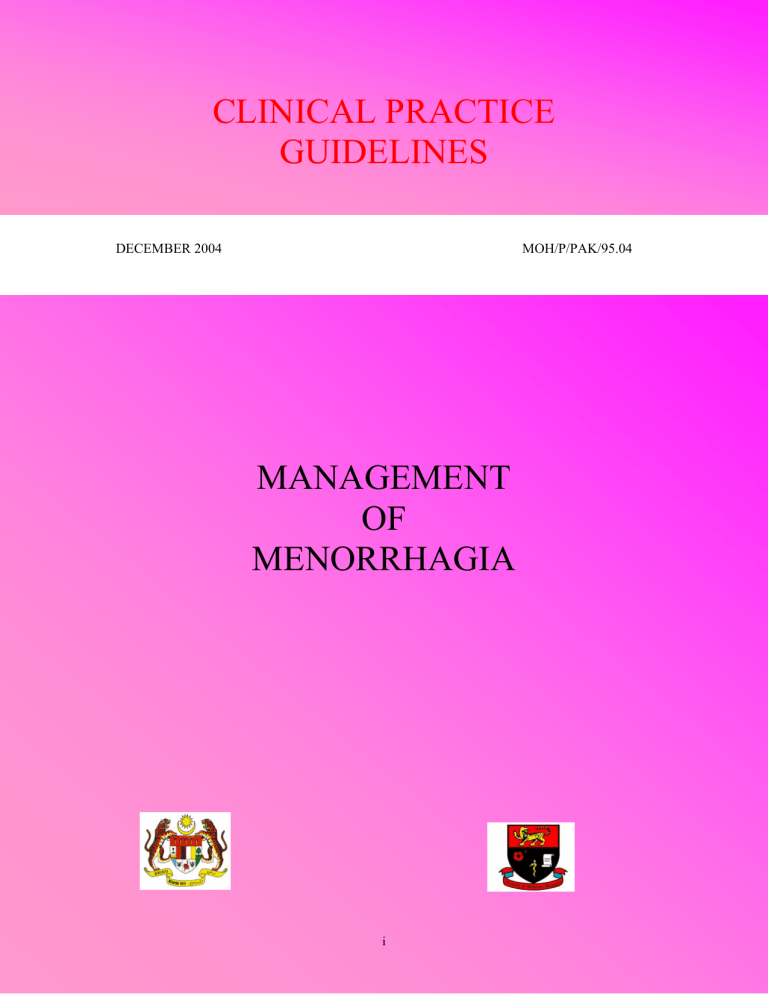
Management of Menorrhagia CLINICAL PRACTICE GUIDELINES DECEMBER 2004 MOH/P/PAK/95.04 MANAGEMENT OF MENORRHAGIA i Management of Menorrhagia MINISTRY OF HEALTH MALAYSIA ACADEMY OF MEDICINE MALAYSIA GUIDELINES DEVELOPMENT AND OBJECTIVES Guidelines Development The work group for the development of these guidelines comprised Obstetricians and Gynaecologists from various Ministry of Health and Ministry of Education facilities. These guidelines were adapted from other international guidelines on management of menorrhagia or heavy menstrual bleeding and modified to suit the local situation. These include guidelines from New Zealand, Canada and the Royal College of Obstetrics and Gynaecologists, UK. A systematic review of current evidence was carried out. Ranking of evidence are based on a modified version of those used by the Catalonia Agency for Health Technology Assessment (CAHTA) Spain; the classification of recommendation was emulated from those used by the Scottish Intercollegiate Guidelines Network (SIGN). The ranking of evidence is based on a modified version of that suggested by the Catalonia Agency for Health Technology Assessment and Research (CAHTAR) Spain, while the grading of recommendations in these guidelines emulates those used by the Scottish Intercollegiate Guidelines Network (SIGN).The draft guidelines were posted on both the Ministry of Health Malaysia and Academy of Medicine, Malaysia websites for comment and feedback. These guidelines have also been presented to the Technical Advisory Committee for Clinical Practice Guidelines and Health Technology Assessment and Clinical Practice Guidelines Council, Ministry of Health Malaysia for review and approval. Objectives The aim of this guideline is to aid doctors in general practice and gynaecologists in clinical decision making, by providing well-balanced information on the management of patients with menorrhagia. Clinical Questions The clinical questions for these guidelines are: i. How should the extent of heavy menstrual flow (menorrhagia) be assessed? ii. How can menorrhagia be alleviated? iii. How can patients with menorrhagia be treated successfully? Target Population These guidelines are developed to apply to women with menorrhagia. Target Group These guidelines are meant for all health care providers. ii Management of Menorrhagia GUIDELINES COMMITTEE 1. Dr Mukudan Krishnan Consultant Obstetrician & Gynaecologist Department of Obstetrics & Gynaecology Ipoh Hospital 2. Dr Lim Keng Joo Consultant Obstetrician & Gynaecologist Department of Obstetrics & Gynaecology Sultanah Aminah Hospital, Johor Bahru 3. Datuk Dr Ghazali Ismail Consultant Obstetrician & Gynaecologist Department of Obstetrics & Gynaecology Tengku Ampuan Afzan Hospital, Kuantan 4. Assoc Prof Dr Ng Soon Pheng Consultant Obstetrician & Gynaecologist Department of Obstetrics & Gynaecology University of Malaya Medical Centre 5 Assoc Prof Dr Nik Mohamed Zaki Nik Mahmood Consultant Obstetrician & Gynaecologist Department of Obstetrics & Gynaecology School of Medical Sciences, Health Campus, Science University of Malaysia 6. Dr Shah Reza Johan Noor Consultant Obstetrician & Gynaecologist Department of Obstetrics & Gynaecology School of Medical Sciences, Health Campus, Science University of Malaysia 7. Dr Ahmad Zailan Hatta Consultant Obstetrician & Gynaecologist Department of Obstetrics & Gynaecology University of Malaya Medical Centre Chairman Guidelines Coordinator Ms Sin Lian Thye Nursing Officer Health Technology Assessment Unit Ministry of Health Malaysia Reviewed and edited by Dr S Sivalal Head, Health Technology Assessment Unit Deputy Director Medical Development Division Ministry of Health Malaysia Acknowledgement We would like to express our deepest gratitude and appreciation to all those who had provided valuable input and feedback on the draft guidelines. iii Management of Menorrhagia LEVELS OF EVIDENCE SCALE Level Strength of evidence 1 2 3 4 Good Good Good to Fair Study design Meta-analysis of RCT, Systematic review Large sample RCT Small sample RCT Non-randomised controlled prospective trial Non-randomised controlled prospective trial with historical control 5 Fair 6 7 Fair Poor 8 Poor Cohort studies Case-control studies Non-controlled clinical series, descriptive studies multi-centre Poor Expert committees, consensus, case reports, anecdotes 9 (Adapted from Catalonian Agency for Health Technology Assessment & Research, [CAHTAR] Spain) GRADE OF RECOMMENDATIONS A B C At least one meta analysis, systematic review, or RCT, or evidence rated as good and directly applicable to the target population Evidence from well conducted clinical trials, directly applicable to the target population, and demonstrating overall consistency of results; or evidence extrapolated from meta analysis, systematic review, or RCT Evidence from expert committee reports, or opinions and /or clinical experiences of respected authorities; indicates absence of directly applicable clinical studies of good quality (Adapted from Scottish Intercollegiate Guidelines Network [SIGN]) iv Management of Menorrhagia TABLE OF CONTENTS 1 2 3 4 Guidelines Development and Objective Guidelines Committee Level of Evidence Scale & Grade of Recommendations BACKGROUND DEFINITION ASSESSMENT AND INVESTIGATION 3.1 Assessment of menstrual blood loss 3.2 Pattern of menstrual blood loss 3.3 Pelvic examination 3.4 Full Blood Count 3.5 Thyroid function tests 3.6 Assessment of endometrium 3.6.1. Ultrasound 3.6.2. Hysteroscopy and endometrial biopsy MANAGEMENT 4.1 Medical Treatment 4.1.1 Non Steroidal Anti Inflammatory Drugs 4.1.2 Progestogens 4.1.3 Combined oral contraceptive pills 4.1.4 Danazol 4.1.5 Anti-fibrinolytic agents 4.1.6 Levonorgestrel intrauterine system 4.1.7 GnRH agonists 4.2 Surgical Management 4.2.1 Medical versus surgical treatment 4.2.2 Dilatation and curettage 4.2.3 Endometrial destruction 4.2.4 Hysterectomy SUMMARY OF RECOMMENDATIONS ALOGRITHM REFERENCES APPENDIX Appendix 1 : Comparison of different drugs used in medical treatment of 1 1 1 1 2 2 2 2 2 3 3 4 4 4 4 4 4 4 5 5 5 5 5 6 6 7 9 10 13 heavy menstrual bleeding Appendix 2 : Comparison of the benefit and side effects of various drugs used in medical treatment of heavy menstrual bleeding 14 Appendix 3: Choice of medical therapy for various conditions Appendix 4 : Decision analysis ranking on the use of medical therapy Appendix 5 :Recommended dosages of medical therapy 15 16 17 v Management of Menorrhagia 1. BACKGROUND Menorrhagia, or heavy menstrual bleeding, is an important cause of ill health in women. It is estimated that 9 to 30 percent of women of reproductive age suffer from menorrhagia, the prevalence increasing with age, and peaking just prior to menopause (Society of Obstetricians and Gynaecologists of Canada, 2001; level 9). Menorrhagia has an impact on many women’s lives, with one in twenty women aged 30 - 49 with menorrhagia consulting their general practitioners each year. It has been found that once referred to a gynaecologist, 60% of women with menorrhagia will have a hysterectomy within five years, accounting for up to 75 percent of all hysterectomies performed worldwide. (RCOG, 1998; 2001; level 9) Apart from surgery, medical therapy, appears to be an attractive treatment option, there being a wide variety of medication available to reduce heavy menstrual bleeding including non-steroidal anti-inflammatory drugs, hormones, anti-fibrinolytics, and intrauterine devices. However, there is considerable variation in practice, and uncertainty, about the most appropriate therapy, due to age, desire to preserve fertility, co-existing medical conditions, and patient preferences (RCOG, 1998; 2001; level 9). 2 DEFINITION Menorrhagia can be defined as a complaint of heavy cyclical menstrual blood loss over several consecutive menstrual cycles in a woman of reproductive years, or more objectively, a total menstrual blood loss of more than 80 ml per menstruation (Hallberg et al, 1966). 3 ASSESSMENT AND INVESTIGATION 3.1 Assessment of menstrual blood loss There is poor correlation between a woman’s perception of heavy menstrual bleeding and menstrual blood loss of more than or equal to 80 ml/cycle, and between the amount of sanitary pads used and the complaint of heavy bleeding (Hallberg et al, 1966; Janssen et al, 1995; level 5). The gold standard for measuring menstrual bleeding is the alkaline haematin test, which is not freely available in most hospitals in Malaysia, since it is currently considered as an investigative tool for research. A simpler alternative to this is the pictorial blood loss assessment chart, that does not involve collection of all used sanitary material. It has also been found to correspond well with the alkaline haematin test (Katrina et al, 2001), and has been validated to be better than the patient’s verbal history alone (Higham et al, 1990; level 5; Janssen et al, 1995; level 5). 1 Management of Menorrhagia 3.2 Pattern of menstrual blood loss It has been noted that while 80-90 % of women with heavy menstrual bleeding have regular cycles, those with prolonged irregular and/or intermenstrual bleeding tend to have other intrauterine pathology (Dijkhuizen et al, 1996; level 5). On the other hand, for perimenopausal women with delayed menstrual cycles, further investigation is only necessary if blood loss is excessive. 3.3 Pelvic examination An abdominal and pelvic examination to exclude obvious pelvic pathology, is advised in all patients. The Malaysian National Cervical Screening Programme has recommended a cervical smear be taken at the time of the pelvic examination, a pelvic ultrasound be carried out to confirm any abnormal finding, and subsequent referral to a gynaecologist as indicated. 3.4 Full Blood Count Since more than two thirds of women with menstrual blood loss greater than 80 ml per cycle have evidence of anaemia, a low haemoglobin reading is considered an objective indicator of heavy menstrual bleeding. However, a normal haemoglobin reading does not necessarily exclude heavy menstrual bleeding (Hallberg et al, 1966; Janssen et al, 1995; level 5). Since the signs and symptoms of anaemia do not correlate well with the haemoglobin level until the patient is moderately to severely anaemic, a full blood count would assist in determining the severity of menstrual blood loss. 3.5 Thyroid function test There is no evidence of heavy menstrual bleeding being associated with thyrotoxicosis, but there is some evidence of association in hypothyroid patients (Krassas et al, 1994; level 9; Attaran et al 1989). Hence, a routine thyroid function test is not recommended. 3.6 Assessment of endometrium Endometrial pathology in pre-menopausal women with abnormal uterine bleeding is uncommon, with only 20% of cases of endometrial cancer occurring before menopause, mostly in women are aged between 40 – 50 years (Crissman et al, 1981; level 9; Jefrery et al, 1997; Mckenzie & Bibby, 1978, ). Endometrial hyperplasia is associated with obesity and age, being more common in women above 45 years of age, with a prevalence of hyperplasia of 2 – 7 % in premenopausal women (Dijkhuzen et al, 1996; level 5; Ash, Farrell & Flowerden, 1996; level 8; Crissman et al, 1981; level 9; Farquhar, 1998). It is a precursor of endometrial cancer, the likelihood of progression depending on the degree of hyperplasia (Ash, Farrell & Flowerden, 1996; level 8; Farquhar, 1998; Kurman, Kaminski & Norm, 1985; level 9 ; Terakawa, 1997; level 9; Hunter et al, 1994; level 9). Infertility and nulli-parity are also significantly associated with hyperplasia. Women who have received tamoxifen appear to be at increased risk of endometrial hyperplasia. However, 14% of the women diagnosed with endometrial hyperplasia had none of the above risk factors. 2 Management of Menorrhagia The Royal College of Obstetricians and Gynaecologists recommends that women with heavy menstrual bleeding but with regular cycles, aged 40 years or less, need not have endometrial samples taken (RCOG, 1994; level 9). However, some authors suggest that women with irregular bleeding or other risk factors for hyperplasia, should have endometrial sampling irregardless of age (Ash, Farrell & Flowerden, 1996; level 9). The commonly used modes of endometrial assessment are ultrasound scan, endometrial biopsy or aspirate, hysteroscopy and dilatation and curettage (D&C). 3.6.1. Ultrasound Ultrasonography is a primary diagnostic tool in evaluating women with abnormal vaginal bleeding, being able to demonstrate anatomic findings not frequently detected in pelvic examination. These include small ovarian cysts, leiomyoma, endometrial carcinoma, as well as evaluation of the endometrium with respect to thickness, which would indirectly reflect the endometrial histology, and hormonal status of patients (Okaro, 2003). Transvaginal ultrasonography (TVS) is an accurate test for diagnosing endometrial hyperplasia when the endometrial thickness is 12 mm or more (Dijkhuizen et al, 1996; level 5; Vercellini et al, 1997; level 5). In women more than 40 years old and who failed medical treatment, 50% have an abnormal TVS (Nagele et al, 1996; level 5) 3.6.2. Hysteroscopy and endometrial biopsy Hysteroscopy allows for the examination of the whole endometrial cavity, lower segment and cervical canal, being able to detect small polyps or sub-mucous fibroids that have been missed by ultrasonography, endometrial biopsy or blind curettage. In women with irregular bleeding, polyps are present in about 25 % of cases and submucous fibroids are present in 15 – 18 % of cases (Fedele et al, 1991; level 5; Dijkhuizen et al, 1996; level 5). Hysteroscopy with biopsy is the best diagnostic test for intrauterine pathology with high specificity and sensitivity (Emanuel et al, 1995; level 5; Dijkhuizen et al, 1996; level 5). Hysteroscopy alone (without biopsy) is not very accurate in diagnosing endometrial hyperplasia and carcinoma (Widrich et al, 1996; level 9; Vercellini et al, 1997; level 5). The main purpose of an endometrial biopsy or aspirate is to exclude endometrial pathology like hyperplasia, endometrial disorders or malignancies. Endometrial biopsy is a simple, quick, safe, and convenient procedure, which can be performed on an ambulatory basis avoiding the need for anesthesia. Furthermore, the device is disposable and is less costly than the conventional D & C. Routine endometrial biopsy should not be an initial investigation for menorrhagia, being indicated only if menorrhagia persists or in the presence of risk factors (RCOG, 1998, level 9). Pipelle and Z sampler could be used as the first line endometrial device as they have been found to be more convenient to use compared to the Vabra aspirator (Bunkheila & Powell, 2002). While the sample adequacy rate was similar for these 3 devices, the 3 Management of Menorrhagia Pipelle has been shown to be superior in the detection of atypical hyperplasia and endometrial carcinoma (Dijkhuizen et al, 1996, level 5). 4 MANAGEMENT 4.1 Medical Treatment 4.1.1 Non Steroidal Anti-Inflammatory Drugs Endometrial prostaglandins are elevated with excessive menstruation, and he nonsteroidal anti-inflammatory drugs (NSAIDs) reduce prostaglandin levels through the inhibition of the cyclo-oxygenase enzyme with reductions in menstrual blood loss of 2535% (Irvine &, Cameron, 1999; level 9). NSAIDs are found to be less effective than tranexamic acid or danazol, but as effective as other medical treatments (Lethaby, Irvine & Cameron, 2003; level 1), with the added advantage of relieving dysmenorrhoea (Fraser et al, 1981; level 3) 4.1.2 Progestogens Progestogens administered from the fifteenth day or from 19th - 26th day of the menstrual cycle were significantly less effective in reducing menstrual blood loss when compared to other medical therapies (Lethaby, Irvine & Cameron, 2003; level 1), and found to be one of the least effective agents (Roy & Bhattacharya, 2004; level 5). However, progestogen therapy administered for 21 days of the menstrual cycle results in a significant reduction in menstrual blood loss, (Lethaby, 2003b; level 1), although they have been found to be ineffective unless taken at high doses (Irvine & Cameron, 1999; level 9). 4.1.3 Combined oral contraceptive pills The combined oral contraceptive pill (OCP) in addition to providing contraception causes a 50% reduction in menstrual blood loss by regular shedding of a thinner endometrium and by inhibiting ovulation (Irvine & Cameron, 1999, level 9). 4.1.4 Danazol Danazol is a synthetic steroid that suppresses oestrogen and progesterone receptors in the endometrium, leading to endometrial atrophy (thinning of the lining of the uterus) and reduced menstrual loss. It is an effective treatment for heavy menstrual bleeding. However, its side-effect profile, its lack of acceptability to women and the need for continuing treatment limits its use (Roy & Bhattacharya, 2004; level 5; Beaumont et al, 2003; level 1). 4.1.5 Anti-fibrinolytic agents Tranexamic acid, a synthetic derivative of the amino acid lysine, exerts an antifibrinolytic effect through reversible blockade on plasminogen, producing a 50% reduction in menstrual loss (Irvine & Cameron, 1999; level 9). Anti-fibrinolytic therapy causes a greater reduction in objective measurements of heavy menstrual bleeding compared to placebo or other medical therapies (Lethaby, Farquhar & Cooke 2003; level 1 Bonnar & Sheppard, 1996, level 1), and is not associated with an increase in side effects (Lethaby, Farquhar & Cooke, 2003; level 1, Lindoff, Rybo & Astedt, 1997; level 5). 4 Management of Menorrhagia 4.1.6 Levonorgestrel intrauterine system The levonorgestrel intrauterine system (LNG IUS) is a T shaped intrauterine device releasing a steady amount of levonorgestrel (20µg /24 hours) from a steroid reservoir around the vertical stem of the device. It reduces menstrual blood loss by 80% (Irvine & Cameron, 1999; Level 9), and is found to be more effective than cyclical norethisterone, with patients being more satisfied and willing to continue with treatment. However, these patients experience more side effects such as inter-menstrual bleeding and breast tenderness (Lethaby, 2003; level 1). Compared to transcervical resection of the endometrium (TCRE), the LNG IUS produces smaller mean reduction in menstrual blood loss, but there is no difference in the rate of satisfaction with treatment. LNG-IUS appears equally beneficial in improving quality of life and may control bleeding as effectively as conservative surgery over the long term (Marjoribanks, Lethaby, & Farquhar, 2003; level 1). 4.1.7 GnRH agonists Gonadatrophin-releasing hormone (GnRH) agonists induce a reversible hypoestrogenic state, reducing total uterine volume. They are highly effective, but their side-effects make them suitable only for short-term use (Irvine & Cameron, 1999, level 9).GnRH agonists may obviate emergency surgery in patients with high surgical risk (Vercellini, 1992; level 3). 4.2 Surgical Management 4.2.1 Medical versus surgical treatment Medical treatment for menorrhagia is not as effective as surgery despite improvement in control of bleeding. Oral medical therapy is associated with higher incidence of side effects, and approximately 60% of women who had medical treatment would require surgery by 2 years. Surgery has been found to reduce menstrual bleeding more than medical treatment at one year, although the majority of women prefer medical treatment (Marjoribanks, Lethaby & Farquhar, 2003; level 1). 4.2.2 Dilatation and curettage There is little evidence on the effectiveness of dilatation and curettage (D&C) for the relief of menorrhagia. It is not cost effective for the diagnosis of endometrial malignancy in women under 40 years since the prevalence of serious uterine conditions and endometrial cancer is low (Coulter et al, 1993; level 9). The potential benefits need to be weighed against the risks of anaesthesia and possible complications like uterine perforation and laceration of the cervix (MacKenzie & Bibby, 1978; level 9). Moreover, a significant proportion of endometrial lesions are not detected by D&C, (Vessey, Clarke, & MacKenzie, 1979) and its usefulness as a diagnostic tool has been repeatedly questioned. D&C may have a diagnostic role when endometrial biopsy is inconclusive and the symptoms persist or when the underlying pathology is suspect. 5 Management of Menorrhagia 4.2.3 Endometrial destruction Endometrial destruction procedures are less invasive, more convenient and less expensive when no other gynecological condition is involved. It enables women to avoid major surgery and results in shorter hospital stay and convalescence. The various energy sources used to destroy the endometrium, are all comparable in terms of efficacy, and the re-operation rate ranges from 0 to 38.2%. The rate is higher in women under the age 35 years in studies where they have been observed for longer duration. The first-generation techniques involve lower costs than a hysterectomy, but the second-generation endometrial destruction techniques involve relatively high purchase and disposable supplies costs. However, these new techniques take less time to perform and have a lower incidence of intra-operative complications. The clinical impact of these two benefits has yet to be demonstrated (AETMIS, 2002; level 1). 4.2.4 Hysterectomy Hysterectomy is the most widely used treatment, and can be performed abdominally, vaginally or laparoscopically. The vaginal and laparoscopic approaches cause fewer complications and provide a shorter hospital stay and convalescence than abdominal hysterectomy. Although with hysterectomy there is a permanent cessation of menstrual flow resulting in a high level of satisfaction, it is a major invasive procedure incurring morbidity, mortality and costs with a risk of late complications as well. (AETMIS, 2002; level 1). Laparoscopic assisted vaginal hysterectomy is associated with longer operating times, and higher operating costs, but total costs are lower than abdominal hysterectomy. 6 Management of Menorrhagia SUMMARY OF RECOMMENDATIONS ASSESSMENT 1. Women should be encouraged to chart their menstrual blood loss using a pictorial blood loss assessment chart (Grade B) 2. Women with erratic bleeding (regardless of loss) should be referred to a specialist as endometrial pathology is likely to be present (Grade B) INVESTIGATION 1. Perimenopausal women with less frequent menstrual cycles but with normal blood loss, do not require further investigation as they are not at increased risk of intrauterine pathology. (Grade C) 2. An abdominal and pelvic examination should be performed in women presenting with heavy menstrual bleeding (Grade C). 3. Full blood count should be offered to all women presenting with heavy bleeding (Grade A). 4. Women with heavy menstrual bleeding with severe anemia, should be referred to a specialist for further assessment (Grade C). 5. Thyroid function test should not be routinely performed in women with heavy menstrual bleeding unless they have signs or symptoms of hypothyroidism (Grade C). 6. Transvaginal sonography, (TVS) if available, should be the first step in assessing the endometrium (Grade B) 7. If the endometrial thickness on TVS is more than 12 mm an endometrial sampling should be done (Grade A) 8. The chance of endometrial carcinoma in women less than 40 years is low and endometrial biopsy is not warranted unless there are associated risk factors, or, if symptoms are persistent or fail to respond to medical treatment (Grade B). 9. Hysteroscopy with biopsy is indicated for women with erratic menstrual bleeding, failed medical therapy, or transvaginal ultrasound suggestive of intrauterine pathology (Grade B) 10. Hysteroscopy with biopsy is indicated in women with menorrhagia if aged more than 40 (Grade B) 7 Management of Menorrhagia MEDICAL TREATMENT 1. NSAIDs are effective for reducing heavy menstrual bleeding (Grade A) 2. Progestogens given in the luteal phase of the menstrual cycle are not effective in reducing regular heavy menstrual bleeding (Grade A) 3. Treatment with progesterone for 21 days (days 5-25) is effective in reducing menstrual blood loss (Grade A) 4. Oral contraceptives can be used to reduce heavy menstrual bleeding (Grade A) 5. Danazol is effective for reducing heavy menstrual bleeding but side effects limit it use (Grade A) 6. Tranexamic acid is effective for reducing heavy menstrual bleeding (Grade A) 7. The levonorgestrel releasing intrauterine system is effective in reducing heavy menstrual bleeding (Grade A) 8. GnRH agonists are highly effective but used for short term only (Grade A) SURGICAL MANAGEMENT 1. Surgical option is more effective in treatment of menorrhagia compared to medical therapy. LNG-IUS is a reasonable alternative to surgical therapy provided patients are aware of possible need for further surgical treatment later (Grade B) 2. While D&C may have a diagnostic role, it is not effective therapy for women with menorrhagia (Grade C) 3. Endometrial destruction procedure provides an alternative treatment option to hysterectomy (Grade A) 4. Vaginal hysterectomy is the most cost-effective mode of hysterectomy (Grade B) 8 Management of Menorrhagia ALOGRITHM OF MANAGEMENT OF MENORRHAGIA Women complaining of heavy menstrual bleeding Full history and physical examination Prolonged irregular menses Heavy menses Assess Uterine size Assess severity of anaemia Refer for further assessment & investigation Severe Not severe Treat anaemia & asses risk of hyperplasia High risk group -bodyweight > 90kg -Age > 40 -other risk factors Assess endometrium -TVS - endometrial biopsy if ET - 12mm or TVS not available Low risk group & unexplained menstrual bleeding Normal endometrium Medical therapy -Levonogestrel intrauterine device -Tranexamic acid - NSAID -Norethisterone -Oral contraceptive pill Treatment Successful If abnormal endometrium No Refer for hysteroscopy or surgery 9 Yes Continue medical therapy Management of Menorrhagia REFERNCES 1. Agence d’évaluation des technologies et des modes d’intervention en santé (AETMIS). Endometrial ablation techniques in the treatment of dysfunctional uterine bleeding. Report prepared by Chantale Lessard and Alicia Framarin. (AETMIS 02-04 RF). Montréal: AETMIS, 2002, xxxi-166 p. 2. Ash SJ, Farrell SA, Flowerden G. (1996) Endometrial biopsy in DUB. J Reprod Med, 41, pp 892-896 3. Attaran M., Boes C, Weber AM, Gidwani G. (1997) Evaluation of adolescents with abnormal uterine bleeding. 1997 4. Beaumont H, Augood C, Duckitt K, Lethaby A (2003) Danazol for heavy menstrual bleeding Cochrane Database Syst Rev. (2):CD001501 5. Bonnar J, Sheppard BL. (1996) Treatment of menorrhagia during menstruation: randomised controlled trial of ethamsylate, mefenamic acid, and tranexamic acid. BMJ; 313, pp 579-582. 6. Bunkheila AK, Powell MC. (2002) Menorrhgia and DUB. Current Obst & Gynecol , 12, pp 328-333 7. Crissman JD, Azoury RS, Barnes AE, Schellhas HF. (1981) Endometrial carcinoma in woman 40 years of age or younger. Obstet Gynecol, 57, pp 699-704 8. Coulter A, Klassen A, MacKenzie IZ, McPherson K. (1993) Diagnostic dilatation and curettage: is it used appropriately? BMJ; 306, pp 236-239. 9. Dijkhuizen FP, Brolmann HA, Potters AE, Bongers MY, Bongers MY, Heinz AP (1996). The accuracy of transvaginal ultrasonography in the diagnosis of endomendometrial thicknessrial abnormalities. Obstendometrial thickness Gynaecol ,87, pp345-349 10. Emanuel MH, Verdel MJ, Wamsteker K, Lannes FB. (1995) A prospective comparison of transvaginal ultrasonography and diagnostic hysteroscopy in the evaluation of patients with abnormal uterine bleeding. Am J Obstet Gynecol, 172, pp 547-552 11. Farquhar CML endometrial thickness by A, Sowter M, Verry J, Baranyai J. (1998) An evaluation of risk factors for endometrial hyperplasia in premenopausal women with abnormal menstrual bleeding ,1998. 12. Fedele L, Bianchi S, Dorta M, Brioschi D, Zanotti F, Vercellini P. (1991) Transvaginal ultrasonography versus hysteroscopy in the diagnosis of uterine submucous myomas. Obstet Gynecol , 77, pp 745-748 13. Guidelines for the management of abnormal menstrual bleeding - Society of Obstetricians and Gynaecologists of Canada, 2001Canada 14. Hallberg L, Hogdahl A, Nilsson L, Rybo G (1966). Menstrual blood loss- a population study: variation at different ages and attempts to define normality. Acta Obstetricia Gynecologica Scandinavica, 45, pp 320-351 15. Higham JM, O’Brien PMS, Shaw RW. (1990) Assessment of menstrual blood loss using a pictorial chart. Br. J Obstet Gynaecol, 97, pp734-9 16. Hunter JE, Tritz DE, Howell MG, DePriest PD, Gallion HH, Andrews SJ et al, (1994) The prognostic and therapeutic implications of cytologic atypia in patients with endometrial hyperplasia. Gynecol Oncol, 55, pp 66 – 71 17. Irvine GA, Cameron IT. (1999) Medical management of dysfunctional uterine bleeding Baillieres Best Pract Res Clin Obstet Gynaeco;13(2), Jun, pp189-202 10 Management of Menorrhagia 18. Janssen CA, Scholten PC, Heintz AP. (1995) A simple visual assessment technique to discriminate bendometrial thicknessween menorrhagia and normal menstrual blood loss. Obstendometrial thicknessrics & Gynecology, 85, pp 977982 19. Jefrery JD, Taylor R, Robertson DI, Stuart GC. (1997) Endometrial carcinoma occurring in patients under the age of 45 years. Am. J Obstet Gynaecol, 261, pp 485-489 20. Katrina MW, Paul WD, Tracy JW, O’Brien PMS. (2001) DEendometrial thickness determination of total menstrual blood loss. Fertility & Sterility,76,(1), pp125-131 21. Krassas GE, Pontikides N, Kaltsas T, Papdopolou P, Batrinos M. (1994) Menstrual disturbances in thyrotoxicosis. Clin Endocrinol, 40 pp 641-644 22. Kurman RJ, Kaminski PF, Norm HJ. (1985) The behaviour of endometrial hyperplasia. A long-term study of untreated hyperplasia in 170 patients. Cancer, 56, pp 403-412 23. Lethaby AE, Cooke I, Rees M. (2000) Progesterone/progestogen releasing intrauterine systems versus either placebo or any other medication for heavy menstrual bleeding. Cochrane Database Syst Rev. (2):CD002126. 24. Lethaby A, Farquhar C, Cooke I. (2000) Antifibrinolytics for heavy menstrual bleeding. Cochrane Database Syst Rev.(4):CD000249 25. Lethaby A, Augood C, Duckitt K (2003a) Nonsteroidal anti-inflammatory drugs for heavy menstrual bleeding. Cochrane Database Syst Rev. (1): CD000400. 26. Lethaby A, Irvine G, Cameron I (2003b) Cyclical progestogens for heavy menstrual bleeding. Cochrane Systematic Review 1 27. Lindoff C, Rybo G, Astedt B. (1993) Treatment with tranexamic acid during pregnancy, and the risk of thrombo-embolic complications. Thromb Haemost, 70: pp 238-240. 28. Marjoribanks J, Lethaby A, Farquhar C. (2003) Surgery versus medical therapy for heavy menstrual bleeding. Cochrane Database Syst Rev. (2):CD003855. 29. MacKenzie IZ, Bibby JG. (1978) Critical assessment of dilatation and curettage of 1029 women. Lancet, 2: 566-568. 30. Nagele F, O’Connor H, Davies A, Badeery A, Mohamed H, Magos A. (1996) 2500 Outpatient diagnostic hysteroscopies. Obstet Gynecol, 88, pp 87-92 31. National Health Committee New Zealand (1998) Guidelines for the management of heavy menstrual bleeding, May 32. Okaro E. (2003) The role of ultrasond in the management of menorrhagia. Review Gynecol Practice,3, pp 16-25 33. RCOG Evidence-based clinical guideline number 1 : The initial management of menorrhagia, 1998. 34. Roy SN, Bhattacharya S (2004) Benefits and risks of pharmacological agents used for the treatment of menorrhagia. Drug Saf, 27(2), pp75-90 35. Terakawa N, Kigawa J, Takendometrial thicknessani Y, Yoshikawa, Yajima A, Noda K. (1997) The behaviour of endometrial hyperplasia: A prospective study. J Obstet Gynaecol Res, 28, pp 223-230 36. Vercellini P, Cortesi I, Oldani S, Moschssta M, De Giorgi O, Crosignani PG. (1997) The role of transvaginal ultrasonography and outpatient diagnostic 11 Management of Menorrhagia hysteroscopy in the evaluation of patients with menorrhagia. Human Reprod, 12, pp 1768-1771 37. Vessey M, Clarke J, MacKenzie I. (1979) Dilatation and curettage in young women. Health Bull, 39: 59-62. 38. Wildrich T, Bradley LD, Mitchinson AR, Collin RL.(1996)Comparison of saline infusion sonography with office hysteroscopy for the evaluation of the endometrium. Am. J Obstet Gynecol,174, pp 1327-1334 12 Management of Menorrhagia Appendix 1 COMPARISON OF DIFFERENCE DRUG USE IN MEDICAL TREATMENT OF HEAVY MENSTRUAL BLEEDING Comparative table of medical therapy for the treatment of heavy menstrual bleeding Drug Mean reduction in blood Women benefiting – loss (%) proportion with MBL<80ml/cycle (%) LNG IUS 94% 100% Oral progesterone (days 5-25) Tranexamic acid 87% 86% 47% 56% NSAIDS 29% 51% OC 43% 50% Danazol 50% 76% Oral progesterone -4% 18% (luteal phase) (Guidelines for the management of heavy menstrual bleeding -New Zealand, 1998) 13 Management of Menorrhagia Appendix 2 COMPARISON THE BENEFIT AND SIDE EFFECT OF VARIOUS DRUG USE IN MEDICAL THERAPY OF HEAVY MENSTRUAL BLEEDING Comparative table of medical therapy for the treatment of heavy menstrual bleeding Drug Specific benefits Adverse benefits LNG IUS Contraception No need tablets Oral progesterone Days 5-25 Tranexamic acid Regular cycles NSAIDs OC Danazol None Relieve dysmenorrhoea, headaches Contraception Relieve dysmenorrhoea & PMS None Menstrual cramps Expulsion IMB Bloating, moody, PMS, nausea Nausea, diarrhoea Nausea, diarrhoea, headache Nausea, breast tenderness, headache Weight gain, acne, hot flushes, bloating, moody, PMS (Guidelines for the management of heavy menstrual bleeding -New Zealand, 1998) 14 Management of Menorrhagia APPENDIX 3 CHOICE OF MEDICAL THERAPY FOR VARIOUS CONDITIONS The choice of medical therapy will be dependent on the individual patient requirements Contraception LNG IUS OC LNG IUS NSAIDs OC NSAIDs Tranexamic acid LNG IUS NSAIDs Tranexamic acid Progestogen followed by clomiphene* OC Cyclic progestogens Cyclic progestogens OC Cyclic HRT GnRH Dysmenorrhoea Unable to tolerate hormones Trying to conceive Adolescents* Perimenopausal women* pre surgery with severe anaemia** Some women who have completed their family may decline medical therapy and choose surgery as a first option Note * Clinical management guidelines for management of an ovulatory bleeding (ACOG, 2000) ** Vercellini P on Gonadotropin releasing hormone agonist treatment for severe menorrhagia in patients with contraindications to surgery, Eur J Obstet Gynecol Reprod Biol. 1992 Jun 16; 45(1):70-2) (Guidelines for the management of heavy menstrual bleeding -New Zealand, 1998) 15 Management of Menorrhagia Appendix 4 DECISION ANALYSIS RANKING ON THE USE OF MEDICAL THERAPY Medical Therapy* Ranking according to decision analysis** LNG IUS 1 Tranexamic acid 2 NSAIDs 2 OC 3 Norethisterone D5-25 15mg daily 3 Danazol 4 (Guidelines for the management of heavy menstrual bleeding -New Zealand, 1998) Note - more than one therapy can be considered - based on efficacy , side effect profile and acceptability to women over 12 months 16 Management of Menorrhagia Appendix 5 RECOMMENDED DOSE OF MEDICAL THERAPY Medical Therapy Tranexamic acid Dosage 1g every 6 hours for the first 4 days NSAIDs D1- D5 or until cessation of menses OC Mefenemic acid 500mg TDS Progestogens D5-25 Norethisterone 15mg daily or Medoxyprogesterone 30mg daily Danazol 100-200mg daily for 3 months OC containing 30ug ethinyloestradiol (Guidelines for the management of abnormal menstrual bleeding -Canada) 17
